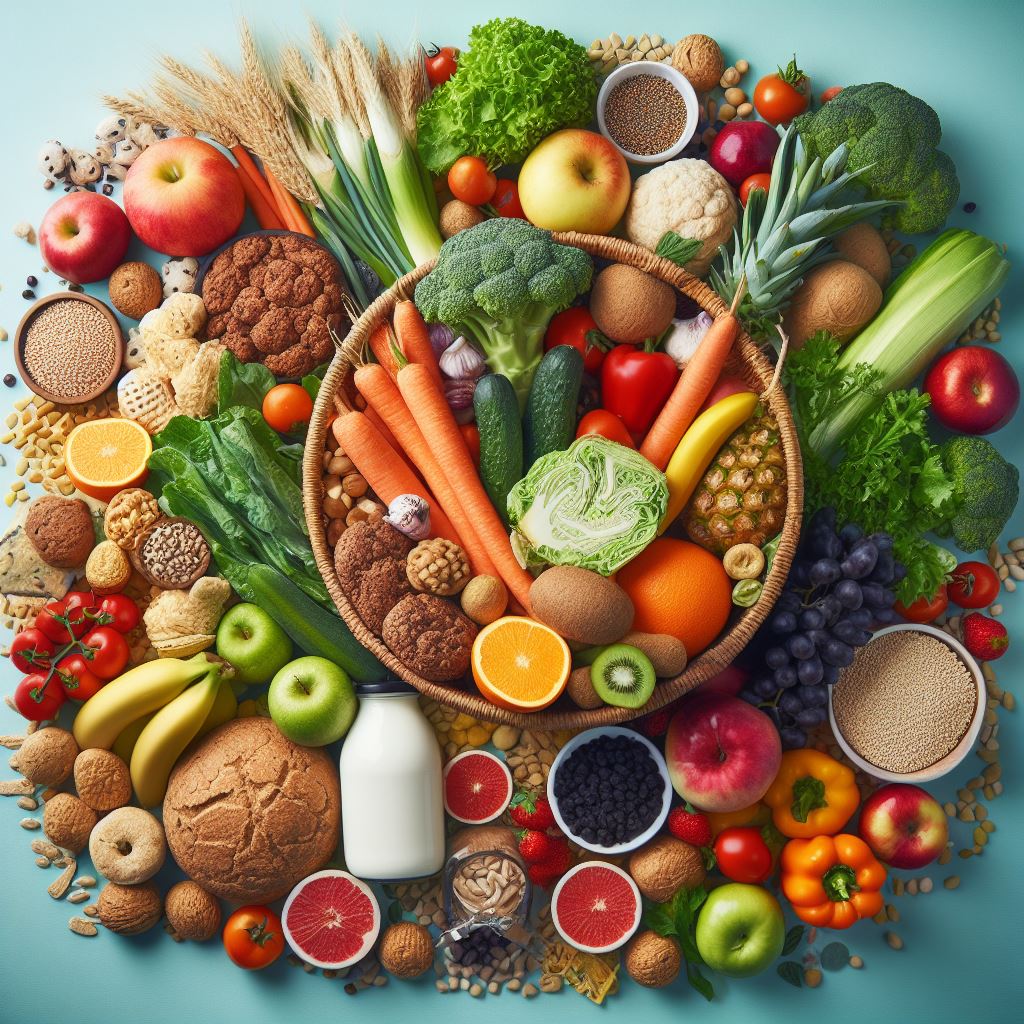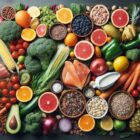15 Healthy Eating Tips for SNAP Recipients

Are you ready to nourish your body and make the most of your SNAP benefits? Look no further! In this article, we’ll share 15 healthy eating tips that will help you stay on track.
From meal planning to budget-friendly recipes, we’ve got you covered. Embrace the power of seasonal produce, make mindful swaps, and cook at home for delicious, nutritious meals.
Let’s dive in and make healthy eating a breeze!
Key Takeaways
- Plan meals ahead of time and create a weekly meal plan with a variety of healthy foods within the SNAP budget.
- Incorporate budget-friendly snacks and seasonal produce into meal planning for affordability, freshness, and essential nutrients.
- Take advantage of buying in bulk to stretch the food budget, reduce packaging waste, and stock up on non-perishable items.
- Focus on incorporating vegetables, lean proteins, and whole grains into meals for essential nutrients, support for muscle mass, and healthy growth and development.
Meal Planning
Plan your meals ahead of time to ensure that you make healthy and nutritious choices while staying within your SNAP budget. Meal planning is a vital step in achieving your health goals and optimizing your grocery budget.
By taking the time to plan your meals, you can avoid impulsive and unhealthy food choices that may derail your progress. Start by creating a weekly meal plan that includes a variety of fruits, vegetables, whole grains, lean proteins, and dairy products. Consider incorporating affordable staple foods like beans, lentils, and rice, which are nutritious and budget-friendly.
When planning your meals, take into account any dietary restrictions or preferences you may have. Additionally, consider the seasonality of produce, as it can affect both the availability and affordability of certain items.
By planning your meals ahead of time, you can create a shopping list that includes only the ingredients you need, preventing unnecessary purchases and reducing food waste. Remember to stick to your meal plan and make adjustments as needed.
With proper meal planning, you can make healthier choices and stretch your SNAP benefits further.
Budget-Friendly Recipes
To make the most of your SNAP benefits and continue making healthy choices, try incorporating budget-friendly recipes into your meal planning. Cooking at home not only saves money but also allows you to have control over the ingredients you use. Here are some budget-friendly recipes that are both nutritious and delicious:
| Recipe Name | Ingredients | Cost |
|---|---|---|
| Vegetable Stir-Fry | Mixed vegetables, soy sauce, garlic, vegetable oil | $5.00 |
| Black Bean Tacos | Black beans, taco shells, lettuce, tomatoes, salsa | $6.50 |
| Lentil Soup | Lentils, onion, carrots, celery, vegetable broth | $4.00 |
| Pasta Primavera | Pasta, mixed vegetables, olive oil, garlic, Parmesan cheese | $7.00 |
| Chickpea Curry | Chickpeas, onion, garlic, curry powder, coconut milk | $5.50 |
These recipes are not only affordable, but they also provide essential nutrients like fiber, vitamins, and minerals. By using simple and inexpensive ingredients, you can create flavorful meals that are good for both your health and your wallet. Remember to plan your meals in advance, make a shopping list, and buy ingredients in bulk when possible to save even more money. With a little creativity and planning, you can enjoy delicious and nutritious meals without breaking the bank.
Healthy Snack Ideas
Continue making healthy choices by incorporating budget-friendly recipes into your meal planning and try these healthy snack ideas. Snacking can be a challenge when trying to maintain a healthy diet, but it’s possible to find nutritious options that won’t break the bank. Opt for snacks that are high in fiber, protein, and healthy fats to keep you satisfied between meals.
One budget-friendly and healthy snack idea is to make your own trail mix. Combine nuts, seeds, and dried fruits for a tasty and nutritious snack that’s easy to take on the go. Another option is to have a piece of fruit with a tablespoon of nut butter. This combination provides a good balance of carbohydrates, healthy fats, and protein.
If you’re in the mood for something savory, try air-popped popcorn seasoned with herbs and spices instead of butter and salt. Popcorn is a whole grain snack that’s low in calories and high in fiber. You can also make your own vegetable chips by thinly slicing vegetables like kale, sweet potatoes, or zucchini, and baking them in the oven until crispy.
Remember to stay hydrated throughout the day by drinking water or unsweetened beverages. Sometimes, thirst can be mistaken for hunger, leading to unnecessary snacking. By choosing healthy snack options and staying hydrated, you can maintain a balanced and nutritious diet while on a budget.
Shop With a List
Make sure you go to the grocery store with a list of the healthy foods you need to buy. Shopping with a list can help you stay focused and avoid impulse purchases of unhealthy foods. It allows you to plan your meals and snacks in advance, ensuring that you have all the necessary ingredients to prepare nutritious meals.
When making your list, include a variety of fruits, vegetables, whole grains, lean proteins, and low-fat dairy products. These foods are key components of a healthy diet and provide essential nutrients for your body. Consider incorporating different colors of fruits and vegetables to ensure you’re getting a wide range of vitamins and minerals.
Additionally, make sure to check your pantry and refrigerator before heading to the store. This will prevent you from buying items you already have and help you avoid waste.
Embrace Seasonal Produce
When it comes to eating healthy on a budget, embracing seasonal produce is a smart choice. Not only are seasonal fruits and vegetables often more affordable, but they also tend to be fresher and more flavorful.
Additionally, seasonal produce is packed with essential nutrients, vitamins, and minerals that can support your overall health and well-being.
Budget-Friendly Seasonal Options
During the summer months, you can save money on groceries by incorporating seasonal produce into your meals. Here are three budget-friendly seasonal options to consider:
- Watermelon: This juicy fruit isn’t only delicious but also affordable during the summer months. It’s a great source of hydration and vitamins A and C. You can enjoy it as a snack, blend it into smoothies, or use it in salads.
- Zucchini: This versatile vegetable is abundant during the summer and can be used in various dishes. It’s low in calories and high in vitamins and minerals. You can spiralize it to make zucchini noodles, roast it as a side dish, or add it to stir-fries.
- Tomatoes: Summer is the perfect time to enjoy fresh and flavorful tomatoes. They’re rich in antioxidants and vitamins. You can use them in salads, sandwiches, or make homemade tomato sauce.
Incorporating these seasonal options into your meals can’t only help you save money but also provide you with nutritious and delicious options.
Nutritional Benefits of Seasons
To maximize the nutritional benefits of seasonal produce, incorporate them into your meals for a boost of vitamins and minerals. Seasonal fruits and vegetables aren’t only fresher and tastier, but they also offer a range of health benefits.
For instance, in the summer, you can enjoy juicy watermelon, which is rich in vitamins A and C, as well as lycopene, a powerful antioxidant.
In the fall, you can savor the sweetness of apples, which are packed with fiber, vitamin C, and phytonutrients.
During winter, citrus fruits like oranges and grapefruits provide a good dose of vitamin C, which can help strengthen your immune system.
Finally, in the spring, you can indulge in vibrant greens like spinach and asparagus, which are excellent sources of vitamins K and folate.
Bulk Buying for Savings
Save money on groceries by buying in bulk. Buying in bulk can help you stretch your food budget and save money in the long run. Here are three reasons why bulk buying is a smart choice for SNAP recipients:
- Cost savings: Buying in bulk often means paying a lower unit price. When you buy larger quantities of food, you can take advantage of discounts and promotions, resulting in significant cost savings over time. By purchasing staple items like rice, beans, and pasta in bulk, you can get more for your money and reduce your overall grocery expenses.
- Reduced packaging waste: Buying in bulk can also help reduce packaging waste. Instead of purchasing individually packaged items, bulk buying allows you to use reusable containers or bags. This not only helps the environment but can also save you money by avoiding the cost of excess packaging.
- Long-term food security: By stocking up on non-perishable items in bulk, you can create a pantry that provides a sense of food security. Having a well-stocked pantry ensures that you always have essential ingredients on hand, reducing the risk of running out of food and relying on costly last-minute purchases.
Choose Whole Grains
When it comes to choosing grains for a healthy diet, whole grains should be your go-to option. Not only are they rich in essential nutrients like fiber, vitamins, and minerals, but they also provide long-lasting energy and help maintain healthy digestion.
Incorporating whole grains into your meals can be simple and cost-effective, whether it’s through options like brown rice, whole wheat pasta, or whole grain bread.
Nutritional Benefits of Whole Grains
For optimal health and nutrition, make sure to incorporate whole grains into your diet on a regular basis. Whole grains are an excellent source of essential nutrients and offer numerous health benefits. Here are three reasons why you should choose whole grains:
- Nutrient-rich: Whole grains contain all three parts of the grain kernel, including the bran, germ, and endosperm. This means they’re packed with important nutrients like fiber, vitamins, minerals, and antioxidants. These nutrients help support a healthy digestive system, lower the risk of chronic diseases, and maintain overall well-being.
- Heart health: Whole grains have been linked to a reduced risk of heart disease. They’re rich in fiber, which can help lower cholesterol levels and regulate blood pressure. Additionally, whole grains contain antioxidants and phytochemicals that have anti-inflammatory properties, further benefiting cardiovascular health.
- Weight management: Including whole grains in your diet can aid in weight management. The fiber content helps you feel fuller for longer, reducing the likelihood of overeating. Whole grains also have a lower glycemic index compared to refined grains, meaning they’ve a slower and steadier impact on blood sugar levels.
Incorporating whole grains into your meals is a simple yet effective way to enhance your nutrition and promote overall health.
Easy Meal Ideas
Include whole grains in your meals for easy and nutritious meal ideas. Whole grains are packed with fiber, vitamins, and minerals that can support your overall health and well-being.
Here are some simple meal ideas that incorporate whole grains:
- Whole grain toast with avocado and eggs: Start your day with a nutrient-dense breakfast by spreading mashed avocado on whole grain toast and topping it with scrambled or poached eggs.
- Quinoa salad: Cook quinoa according to package instructions and toss it with your favorite veggies, such as cucumbers, tomatoes, and bell peppers. Add a squeeze of lemon juice and a drizzle of olive oil for a refreshing and filling meal.
- Brown rice stir-fry: Cook brown rice and stir-fry it with a variety of colorful vegetables and lean protein like chicken or tofu. Season with low-sodium soy sauce for a flavorful and satisfying dish.
Cost-Effective Options
To make the most of your SNAP benefits, prioritize cost-effective options by choosing whole grains for your meals. Whole grains aren’t only affordable but also offer numerous health benefits. Here are three reasons why you should include whole grains in your diet:
- Nutritional value: Whole grains contain all parts of the grain, including the bran, germ, and endosperm. This means they’re rich in fiber, vitamins, minerals, and antioxidants, providing essential nutrients for your body.
- Satiety: Whole grains are more filling than refined grains, which can help control your appetite and prevent overeating. This is especially important when you’re on a budget and need to make your meals last.
- Versatility: Whole grains can be incorporated into a variety of dishes, from breakfast cereals and bread to side dishes and main courses. By including whole grains in your diet, you can enjoy a wide range of flavors and textures while still maintaining a budget-friendly approach to eating.
Incorporate More Vegetables
To boost your vegetable intake, aim to consume at least three servings of various vegetables each day. Vegetables are an excellent source of essential vitamins, minerals, and fiber that support overall health and well-being. They can help reduce the risk of chronic diseases such as heart disease, stroke, and certain types of cancer. Incorporating more vegetables into your diet can be easy and cost-effective. Here are some tips to get you started:
| Tips for Incorporating More Vegetables | |
|---|---|
| 1 | Add vegetables to your favorite dishes, such as soups, stews, and casseroles. |
| 2 | Snack on raw vegetables with a delicious dip, like hummus or yogurt. |
| 3 | Try different cooking methods, such as roasting, steaming, or grilling, to enhance the flavor of vegetables. |
| 4 | Experiment with a variety of vegetables to discover new flavors and textures. |
| 5 | Buy frozen vegetables when fresh options are limited or expensive. They are just as nutritious and can be stored for longer periods. |
Opt for Lean Protein
To continue diversifying your diet and maximizing the health benefits of your SNAP benefits, opt for lean protein options. Including lean protein in your diet is essential for maintaining muscle mass, supporting healthy growth and development, and promoting overall well-being. Here are three lean protein options to consider:
- Skinless poultry: Chicken and turkey are excellent sources of lean protein. They’re low in fat and high in essential nutrients like vitamins B6 and B12, niacin, and selenium. You can bake, grill, or roast them for a delicious and healthy meal.
- Fish and seafood: Fish such as salmon, tuna, and trout are rich in omega-3 fatty acids, which are beneficial for heart health. Shrimp, crab, and lobster are also great sources of lean protein. Aim to include fish and seafood in your diet at least twice a week for maximum health benefits.
- Legumes: Beans, lentils, and chickpeas aren’t only affordable but also packed with protein, fiber, and essential micronutrients. They’re versatile ingredients that can be added to soups, stews, salads, and even used as a meat substitute in dishes like veggie burgers and tacos.
Reduce Sugar Intake
To reduce your sugar intake, it’s important to be aware of hidden sources of sugar in your diet. Many processed foods, such as sodas, juices, and snacks, contain high amounts of added sugars that can contribute to health risks like obesity, diabetes, and heart disease.
Hidden Sugar Sources
Cut back on the amount of added sugar in your diet by being mindful of hidden sources. While it’s easy to identify sugary treats like cookies and sodas, hidden sugars can lurk in unexpected places.
Here are three common hidden sugar sources to watch out for:
- Condiments: Many condiments, such as ketchup, barbecue sauce, and salad dressings, contain added sugars to enhance flavor. Check the labels and opt for healthier alternatives or make your own at home.
- Flavored Yogurt: Flavored yogurts often contain high amounts of added sugars. Choose plain yogurt and add fresh fruits or a drizzle of honey for natural sweetness.
- Packaged Snacks: Granola bars, fruit snacks, and flavored rice cakes may seem like healthy options, but they can be loaded with hidden sugars. Look for snacks with minimal added sugars or choose whole foods like fresh fruits and vegetables.
Being aware of these hidden sugar sources will help you make healthier choices and reduce your sugar intake.
Health Risks Associated
Reduce your risk of health problems by decreasing your intake of sugar. Consuming excessive amounts of added sugars has been linked to various health issues, including obesity, type 2 diabetes, heart disease, and tooth decay. The American Heart Association recommends limiting your daily sugar intake to no more than 6 teaspoons (25 grams) for women and 9 teaspoons (38 grams) for men. To put it into perspective, a single can of soda contains about 10 teaspoons (40 grams) of sugar. By reducing your sugar consumption, you can improve your overall health and well-being. Check food labels for hidden sources of sugar and opt for healthier alternatives whenever possible. Choose fresh fruits, vegetables, whole grains, and lean proteins to maintain a balanced diet and minimize your risk of developing chronic health conditions.
| Health Risks Associated with Excessive Sugar Intake | |
|---|---|
| Obesity | Increased risk of weight gain and obesity-related health problems such as heart disease and type 2 diabetes. |
| Type 2 Diabetes | Higher sugar intake can lead to insulin resistance, increasing the risk of developing type 2 diabetes. |
| Heart Disease | High sugar consumption contributes to high blood pressure, inflammation, and other risk factors for heart disease. |
| Tooth Decay | Frequent sugar consumption promotes the growth of harmful bacteria in the mouth, leading to tooth decay and cavities. |
| Nutritional Deficiencies | Foods high in added sugars often lack essential nutrients, contributing to poor overall nutrition and deficiencies. |
Limit Processed Foods
Make sure you’re mindful of the amount of processed foods that you’re consuming while on SNAP. While these foods may be convenient and affordable, they’re often high in unhealthy additives and lack essential nutrients. Here are three reasons why it’s important to limit processed foods in your diet:
- Nutritional Value: Processed foods are typically stripped of their natural nutrients during the manufacturing process. They’re often loaded with added sugars, unhealthy fats, and high levels of sodium. These additives can contribute to weight gain, high blood pressure, and other chronic health conditions.
- Lack of Fiber: Many processed foods lack the fiber content that’s essential for a healthy diet. High-fiber foods help regulate digestion, control blood sugar levels, and promote feelings of fullness. By choosing whole, unprocessed foods like fruits, vegetables, and whole grains, you can increase your fiber intake and improve your overall health.
- Hidden Ingredients: Processed foods often contain hidden ingredients, such as artificial sweeteners, preservatives, and food additives. These substances have been linked to various health issues, including allergies, digestive problems, and even cancer. By opting for fresh, whole foods, you can avoid these hidden dangers and make healthier choices for yourself and your family.
Drink Plenty of Water
To maintain optimal health and hydration, it’s important for SNAP recipients to prioritize drinking an adequate amount of water throughout the day. Water is essential for various bodily functions, such as digestion, nutrient absorption, and temperature regulation. It helps transport oxygen and nutrients to cells, flushes out toxins, and keeps the skin healthy.
Drinking plenty of water can also aid in weight management. Research shows that staying hydrated can help reduce calorie intake, increase metabolism, and promote feelings of fullness. This is especially important for SNAP recipients who may have limited access to nutritious foods.
While sugary drinks may be more affordable and readily available, they’re often high in calories and contribute to weight gain and various health problems. Water, on the other hand, is calorie-free and can quench your thirst without adding extra sugar or artificial ingredients to your diet.
Aim to drink at least eight cups (64 ounces) of water per day, or more if you’re physically active or live in a hot climate. Carry a refillable water bottle with you to make it easier to stay hydrated throughout the day.
Make Healthy Swaps
Choosing healthier alternatives can help you make positive changes to your diet and improve your overall well-being. Making healthy swaps is a great way to reduce your intake of unhealthy ingredients and increase your consumption of nutrient-dense foods.
Here are three simple swaps you can make to enhance the nutritional value of your meals:
- Swap white bread for whole grain bread: Whole grain bread is rich in fiber, vitamins, and minerals, while white bread is often stripped of these nutrients during processing. By choosing whole grain bread, you can increase your fiber intake and promote better digestion.
- Swap sugary drinks for infused water: Sugary drinks like soda and fruit juices are high in added sugars and empty calories. Instead, opt for infused water by adding slices of fresh fruits or herbs to your water. This not only adds natural flavors but also provides essential vitamins and minerals.
- Swap processed snacks for homemade alternatives: Processed snacks like chips and cookies are typically high in unhealthy fats, sodium, and artificial additives. Try making your own snacks using fresh ingredients, such as air-popped popcorn, homemade trail mix with nuts and dried fruits, or baked vegetable chips.
Cook at Home
Enhancing the nutritional value of your meals can be achieved by cooking at home. When you cook your own meals, you have full control over the ingredients you use and the cooking methods you employ. This allows you to make healthier choices and avoid added sugars, unhealthy fats, and excessive sodium that are often found in processed and restaurant foods.
Research shows that individuals who cook at home tend to consume fewer calories, less unhealthy fats, and more nutrient-dense foods compared to those who eat out frequently. By preparing your meals at home, you can incorporate a variety of whole grains, lean proteins, fruits, and vegetables into your diet, which are essential for a well-balanced and nutritious meal.
Additionally, cooking at home can also save you money. It’s often more cost-effective to buy ingredients in bulk and cook multiple servings, which can be portioned and enjoyed throughout the week. This can help stretch your budget and ensure that you have nutritious meals readily available.
Practice Mindful Eating
To truly benefit from the practice of mindful eating, it’s important to understand its benefits, learn various techniques, and incorporate mindfulness into your meals.
Mindfulness can help you develop a healthier relationship with food, improve portion control, and enhance your overall eating experience. By being fully present and aware of your food choices, eating habits, and bodily sensations, you can make more informed decisions and cultivate a greater sense of satisfaction and enjoyment during meals.
Benefits of Mindfulness
Improve your eating habits by incorporating mindful eating techniques. Practicing mindfulness while eating can offer several benefits that can positively impact your overall health and well-being.
Here are three key benefits of mindful eating:
- Weight management: Mindful eating helps you become more aware of your body’s hunger and fullness cues. By paying attention to these signals, you’re less likely to overeat or indulge in unhealthy foods, leading to better weight management.
- Improved digestion: Mindful eating encourages you to eat slowly and savor each bite. This allows your body to properly digest the food, leading to better nutrient absorption and reduced digestive discomfort.
- Enhanced enjoyment of food: By being fully present during meals, you can fully appreciate the flavors, textures, and aromas of your food. This can enhance your overall dining experience and bring you more satisfaction from your meals.
Incorporating mindful eating into your daily routine can have a positive impact on your eating habits and overall well-being. Give it a try and experience the benefits for yourself.
Mindful Eating Techniques
Practice mindful eating by incorporating these simple techniques into your daily meals. Start by paying attention to your hunger and fullness cues. Before eating, take a moment to assess your level of hunger. Eat when you’re moderately hungry, and stop when you’re comfortably full.
Avoid distractions such as watching TV or using your phone while eating. Instead, focus on the taste, texture, and aroma of your food. Chew slowly and savor each bite. This allows your brain to register the satisfaction of eating, reducing the likelihood of overeating.
Additionally, try to eat in a calm and relaxed environment to enhance your mindfulness. By practicing these techniques, you can improve your relationship with food and make healthier choices.
Now, let’s explore how to incorporate mindfulness into your meals.
Incorporating Mindfulness Into Meals
Incorporate mindfulness into your meals by continuing to practice mindful eating techniques. Mindful eating involves paying attention to the present moment and being fully aware of your eating experience.
Here’s how you can incorporate mindfulness into your meals:
- Slow down: Take your time while eating and savor each bite. Eating slowly allows you to fully experience the flavors and textures of your food.
- Engage your senses: Notice the colors, smells, and tastes of your meal. Pay attention to the sounds and textures as you chew.
- Listen to your body: Tune in to your hunger and fullness cues. Eat when you’re hungry and stop when you’re satisfied, rather than eating out of habit or until you’re uncomfortably full.
Frequently Asked Questions
How Can I Make Healthy Choices When Eating Out at Restaurants?
When eating out at restaurants, you can make healthy choices by opting for grilled or baked dishes instead of fried ones, choosing salads with lean proteins, and asking for dressings on the side.
Are There Any Specific Foods I Should Avoid When Trying to Eat Healthier?
When trying to eat healthier, it’s important to avoid certain foods. Processed snacks, sugary drinks, and fried foods may taste good but can negatively impact your health. Choose nutrient-dense options instead.
What Are Some Strategies for Staying Motivated to Eat Healthy?
To stay motivated to eat healthy, set small achievable goals, find healthy recipes you enjoy, involve friends or family, and remind yourself of the benefits of eating well. Keep it simple and make it a lifestyle.
Can You Provide Tips for Meal Prepping and Batch Cooking?
To meal prep and batch cook, start by planning your meals and making a grocery list. Cook larger portions and divide them into individual servings for easy grab-and-go meals throughout the week.
How Can I Incorporate More Fruits and Vegetables Into My Meals if I Don’t Particularly Enjoy Them?
If you don’t enjoy fruits and veggies, try incorporating them into dishes you already like. Blend spinach into smoothies or add diced veggies to pasta sauce. Small changes can make a big difference.



